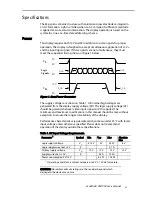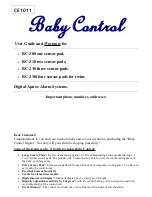
EL480.240-PR2/PR3 Users Manual
10
Self-Test Mode
The display incorporates a self-test mode composed of two patterns displayed
for approximately 30 seconds each, and then repeated. The patterns are as
follows: Diagonal Lines, Diagonal Lines Inverted, Full On, 1 x 1 Checkerboard,
and 1 x 1 Checkerboard Inverted. The self-test mode is entered by resetting or
applying power to the display with the VCLK signal static. The display will
remain in the self-test mode until two edges of VCLK are detected.
Optical
Table 5. Optical Characteristics.
Luminance
Lon (areal), min
Lon (areal), typ
Loff (pixel), max
30 cd/m
²
50 cd/m
²
0.3 cd/m
²
screen center, 120 Hz frame rate
screen center, 120 Hz frame rate
5 points: center plus four corners measured
1.0
r
0.25" from adjacent display edges, 120 Hz
Non-uniformity
All pixels fully lit
26%
Maximum difference two of five points, using the
formula:
LNU%=[1- (min_lum/max_lum)] x 100
Luminance Variation (Temperature)
Maximum
r
15%
Across operating temperature range
Luminance Variation (Time)
Maximum
<10%
15,000 hours at 25
q
C ambient
Viewing Angle
Minimum
160
q
Contrast Ratio
Minimum
Typical
19:1
50:1
@ 500 lux ambient, 120 Hz frame rate
Generating Grayscales
Some applications may benefit by using grayscales. The PR2/PR3 has a
maximum frame rate frequency of 120 Hz. Using the higher frame rate,
combined with flat panel controllers designed for this faster display, it is
possible to generate usable grays through frame rate control and dithering.
Video controllers from manufacturers such as C&T and EPSON use these
methods with proprietary algorithms to generate grayscales.
The response time of electroluminescent displays is much faster than LCDs,
therefore not all possible grayscales generated by the video controller are actually
usable. Many of the grayscales may flicker or swim. Careful testing is necessary to
select appropriate grayscales for an application, especially when the
electroluminescent displays are driven at less than their maximum frame rate. For
additional information, refer to Planar Application Note 119 or contact Planar's
Application Engineers.


































